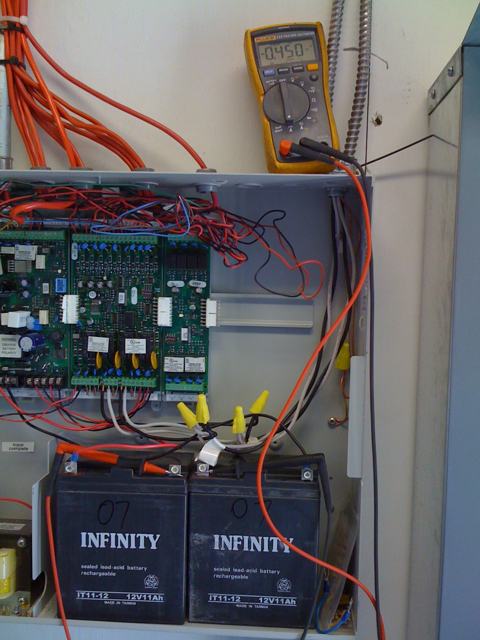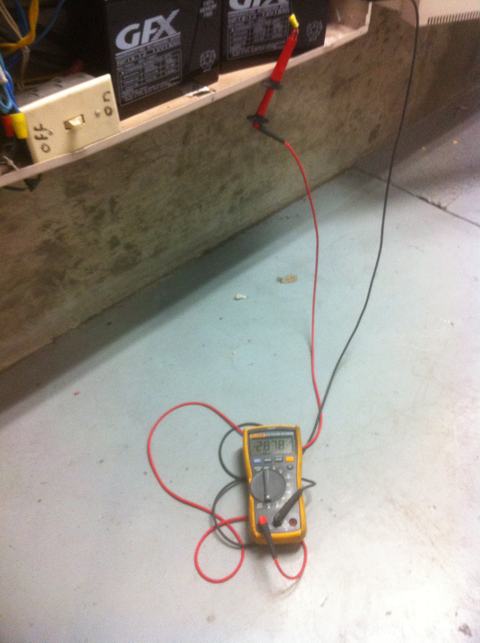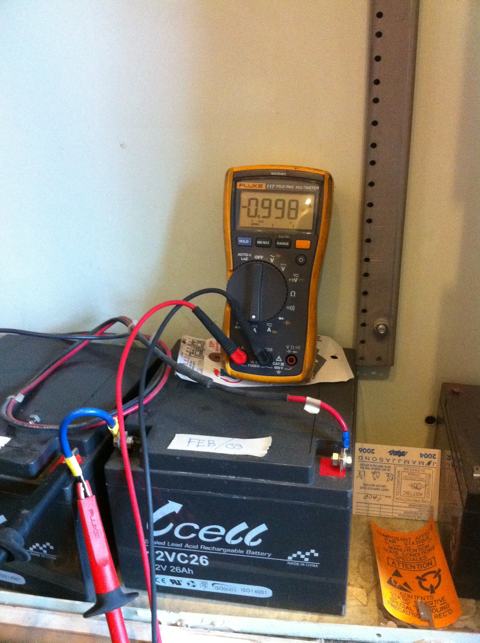DEBUNKING THE MYTHS & COMMON MISCONCEPTIONS ABOUT BATTERY/POWER SUPPLY TESTING!
By Frank Kurz
Common Myths and Misconceptions:
#1 - I don't have to test the batteries.
#2 - I must only replace the batteries with the same type and rating as originally supplied at the time the system was installed and verified.
#3 - I only have to document the test of the common control (base panel) power supply and battery.
#4 - I don't ever have to perform adjustments to the system’s battery charger.
#5 - Any building with an emergency generator only has to be equipped with standby batteries of sufficient capacity to ensure a smooth transition during the start-up and transfer sequence.
![]()
Some Battlefield Examples:
Example #1:
 |
Special Reports & Feature Stories!
CAN/ULC-536-13 (Canadian Annual Fire Alarm Inspection Standard)
DO’S AND DON’T’S
This is an Edwards QS (QuickStart) panel located in a small strip mall in Chilliwack. I think we can safely assume the batteries were replaced in 2007. With the power "off", I show a supervisory current draw of 450 mA.
Example #2:
 |
This is a Simplex 4000 networked system located in a twin high-rise complex equipped with an emergency generator. The batteries in the cabinet are date coded for 2009 (which means they were probably replaced during the last inspection in December). The meter reading here is 2.878 Amps - that's the supervisory current for the main control and display module you're looking at. Testing was pretty easy here. Notice the switch installed in the cabinet next to the batteries. This is a common occurrence in large networked systems because it makes testing and set-up "easy". It's normally NOT ALLOWED. In order to get at this particular switch, you have to remove the panel "dead-front". The amplifier cabinet is next to this one. The same 18AH batteries are installed there. Supervisory current on that particular pair was 5.18 Amps.
Example #3:
 |
This is a Chubb-Edwards EST-3 command centre with a graphic annunciator in a high-rise building in Burnaby (it's also the subject of the discussion I outlined in the introduction to this Series (it's unfortunately escalated to a full blown complaint now). In this example the supervisory current is 998 mA (close enough to be 1 Amp). The 26 AH batteries were replaced last year. I was told that this was the size of the batteries originally supplied with the system (that Edwards had engineered the system this way). The common control (located in the basement) had the same size batteries with a supervisory current of 790 mA.
![]()
INSPECTION STANDARD REQUIREMENTS:
Let's review the relevant sections of CAN/ULC-S536-13 as they apply to battery and power supply testing. Section 6.3 is entitled POWER SUPPLIES and it states:
“6.3.2 Each battery shall be inspected and tested to confirm operability, including the following functions, as applicable (Refer to Appendix C2.5, Emergency Power Supply Test and Inspection):
|
|
A |
Correct type as recommended by manufacturer; |
|
|
|
|
|
|
|
|
B |
Correct rating as determined by battery calculations based on full system load; |
|
|
... |
|
|
|
|
|
P |
Perform battery tests demonstrating specified battery operation as follows, after which the battery voltage should not be less than 85% of its rating after the tests, otherwise replace batteries (Refer to Appendix F, Battery Tests). |
|
|
|
|
(i) |
Required supervisory load for 24 h followed by the required full load operation, or |
|
|
|
(ii) |
A silent test by using the load resistor method may be used for the full duration test (Refer to Appendix F1, Silent Test); or |
|
|
|
(iii) |
Silent accelerated test. (Refer to Appendix F2, Silent Accelerated Test); or |
|
|
|
(iv) |
A battery capacity meter test. (Refer to Appendix F3, Battery Capacity Meter Test); or |
|
|
|
(v) |
In liew of the above battery tests, replace the battery with a new set having a current date code, amp-hour capacity and of a type as recommended by the manufacturer of the fire alarm system. NOTE: Ensure that the battery is within the charging capacity of the battery charger, as recommended by the manufacturer.” |
What does this Clause actually say?
It specifically states “each battery shall be inspected and tested to confirm operability”! If your system has more than one set of batteries, they MUST be tested and the INDIVIDUAL results recorded in the inspection report!
What do the first two sub-clauses mean?
“A” refers to battery type which means it's either a sealed lead acid (SLA), wet lead, ni-cad, or some other type as “recommended by manufacturer”.
“B” means you have to ensure battery is rated correctly to ensure the system's full load capacity meets the requirements of the relevant sections of the Building Code (or local ordinance) for the type of occupancy and “P” of the referenced Standard.
![]()
BUILDING CODE REQUIREMENTS:
Let's review the British Columbia Building Code Division “B” Part 3. Because it's based on the National Building Code I'm pretty sure the wording and references are good for other provinces. It is where we'll find:
“3.2.7.8 Emergency Power for Fire Alarm Systems
|
1) |
Fire alarm systems, including those incorporating a voice communication system, shall be provided with an emergency power supply conforming to Sentences (2), (3), and (4). |
||
|
|
|
|
|
|
2) |
The emergency power supply required by Sentence (1) shall be supplied from: |
||
|
|
a) |
a generator |
|
|
|
b) |
batteries, or |
|
|
|
c) |
a combination thereof. |
|
|
|
|
|
|
|
3) |
The emergency power supply required by Sentence (1) shall be capable of providing: |
||
|
|
a) |
supervisory power for not less than 24 h, and |
|
|
|
b) |
immediately following that period, emergency power under full load for not less than: |
|
|
|
|
i) |
2 h for a building within the scope of Subsection 3.2.6, |
|
|
|
ii) |
1 h for a building classified as a Group B major occupancy that is not within the scope of Subsection 3.2.6, |
|
|
|
iii) |
h for a building constructed in accordance with Article 3.2.2.50, or 3.2.2.58., |
|
|
|
iv) |
5 min for a building not required to be equipped with an annunciator, and |
|
|
|
v) |
30 min for any other building. |
|
(See Note A-3.2.7.8.(3).) |
|||
|
|
|||
|
4) |
The emergency power supply required by Sentence (1) shall be designed so that, in the event of a failure of the normal power source, there is an immediate automatic transfer to emergency power with no loss of information.”
|
||
![]()
DISPELLING THE MYTHS (AND SOME SUGGESTIONS):
As you can see, the standby requirements (and associated testing criteria) for a fire alarm system are fairly stringent and should leave you with no doubt as to what you should be looking for. If the building is equipped with a generator, for instance, you must determine whether it meets the required supervisory and full load capacity for the fire alarm system. Calculations for this must not only include the minimum fuel level, but also an appropriate “trouble” indication at the fire alarm panel should the level fall below the required run time. This means you must examine any relevant onsite documentation to ensure it's CERTIFIED to provide the rated back-up power. If you can't find the appropriate documentation (or have doubts with respect to the condition of the generator, its maintenance or testing), you MUST ensure that the back-up batteries can meet the demand instead.
Both the Testing Standard and Building Code reference the phrase fire alarm system, not a control or a portion of a system. This means you must test EVERY battery and power supply associated with it. It's one of the reasons why our testing forms are designed so that it makes this aspect of the inspection requirement easy to document. Moreover, it makes expanding the report to include additional power supplies and batteries easy to do as well (you just have to remember to renumber the appropriate sections).
DO NOT RELY on the Verification documentation or the bill of material which may be appended to it. It's important for you to realize that the individual who performed the Verification cannot be relied upon anymore than the last technician that performed the annual test on the system before you can (or anyone else involved in the original build-out). The manufacturer stipulates the type of battery and may even set limits on the size of battery a particular power supply can handle (they also provide the means to calculate the standby requirements of the system). Some older common controls enable (and may even require) you to “trim” the charger to more closely fit the recommended parameters of the battery you're installing (or servicing). This makes having access to the installation manuals for the system you're testing absolutely essential.
![]()
CALCULATING BATTERY STANDBY REQUIREMENTS:
In most instances, the manufacturer provides a form for you to utilize in calculating the size of the battery required. I strongly advocate that you cross-check the number this yields with an actual empirical measurement utilizing a good quality meter. I would not recommend using the clamp-on style meter for this. Here’s the correct method for measuring standby and alarm current of a conventional (or addressable) fire alarm panel (with no EVCS system):
- Disconnect the jumper between the two batteries that normally form the 24VDC supply. The fire alarm system should annunciate a trouble condition. (This also happens to be part of the testing criteria!)
- Set your multi-meter for “DC AMPS” and ensure the leads are connected properly.
- Clamp the RED (positive) lead to the RED (postive) terminal that the jumper you removed in step 1 was connected to.
- Clamp the BLACK (negative) lead to the BLACK (negative) terminal that the jumper you removed in step 1 was connected to.
- The fire alarm trouble indication should clear and the system should appear “normal” in all respects. The current you see displayed is the nominal charging current being output to the battery (it should appear as a “negative” number if you’ve connected everything properly).
- Turn off the circuit disconnect means to the fire alarm system. The ammeter should now display the system’s supervisory current (a positive number). DON’T SILENCE THE TROUBLE INDICATION JUST YET!
- Turn off the circuit disconnect means to the sprinkler heat trace controller (if provided). The reason for this is that we are simulating a power failure to the building which means the fire alarm panel should display all associated troubles and supervisories in order to accurately measure the supervisory standby current.
- If your meter is equipped with a “MAX/MIN” setting, engage it and wait for the display to stabilize at the highest current reading.
- Record the reading on your test report.
- Initiate an alarm on the fire alarm system by triggering a device or zone. Wait for the reading to stabilize.
- Record the alarm current reading on your test report.
- Silence the alarm and trouble signals.
- Turn off the “MAX/MIN” setting on your meter.
- Restore power to the heat trace controllers.
- Reset the system.
- Restore power to the fire alarm system and observe the charging voltage. It should read higher than the nominal charging voltage you recorded earlier. This is normal. You will observe that this reading will drop gradually as the system stabilizes and should return to the nominal reading you first observed.
- Remove the meter’s leads and restore the connection through the battery jumper you removed in step 1. (Don’t forget to move the meter leads back to the normal “voltage” slot on your meter!)
- Take the supervisory current you recorded and multiply by twenty-four.
- Divide the alarm current by two (if the Code requirement is for 30 minutes of alarm time). Multiply the alarm current by two (if the Code requirement is for two hours of alarm time).
- Add the results of step 18 and step 19 together and multiply by the manufacturer’s recommended de-rating factor (this is commonly “1.2”).
- Compare this with the results you’ve obtained by using the manufacturer’s battery standby calculation form.
- Round up the number you get in step 20 if it’s more than the number you calculated in step 21 (otherwise use the number you obtained in step 21). This is the MINIMUM battery capacity for the system under test.
![]()
TIPS AND RESOURCES:
Nothing beats being able to physically check the actual current draw (using a good quality meter).
You must approach EVERY inspection like a sceptic. This ensures you have the necessary focus to complete a thorough review of the building's life safety systems. We review the correct procedure (required by ASTTBC’s Practice Guideline under the heading Preparation) that you should follow prior to performing any life safety equipment testing in this FAQ.
Calculating the size of the batteries using a de-rating factor is described in our GLOSSARY.
There is additional information regarding the Annual Testing of Fire Protection Equipment located on our FAQS page.
![]()
Questions?
Call or email us!
|
|
|
||
|
|
|||
|
|
|
The Fire Technicians Network
+1 (888) 340-3473
“We are not a professional union, but together, we are a union of professionals!”
What we’re all about!
We are not affiliated with ASTTBC, CFAA, CANASA, NFPA, NAFED, or NICET (although we encourage you to explore and objectively evaluate the benefits associated with supporting their individual efforts). Membership in the Fire Technicians Network is entirely voluntary. Are you up to the challenge of demonstrating your commitment to public safety and the highest standard of professional practice?
Copyright © 2007 - 2021 The Fire Technicians Network. All Rights Reserved